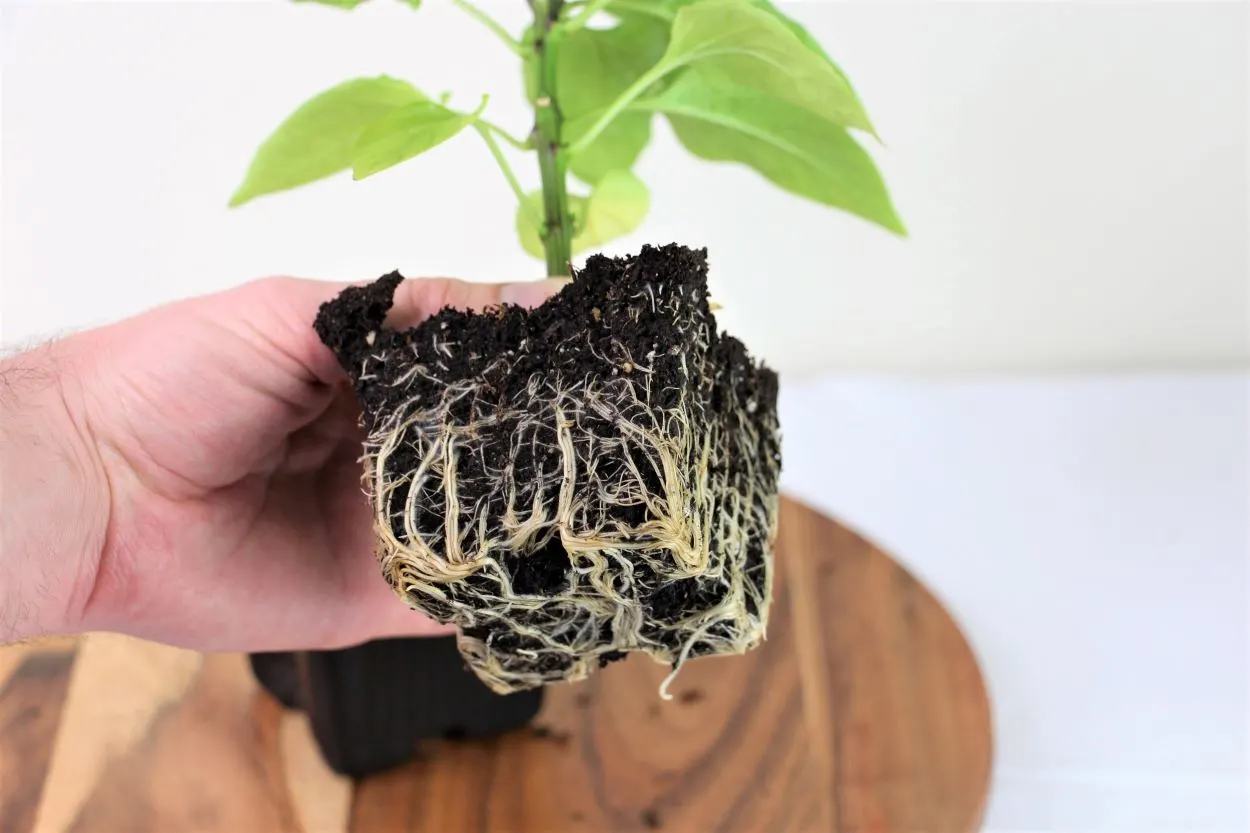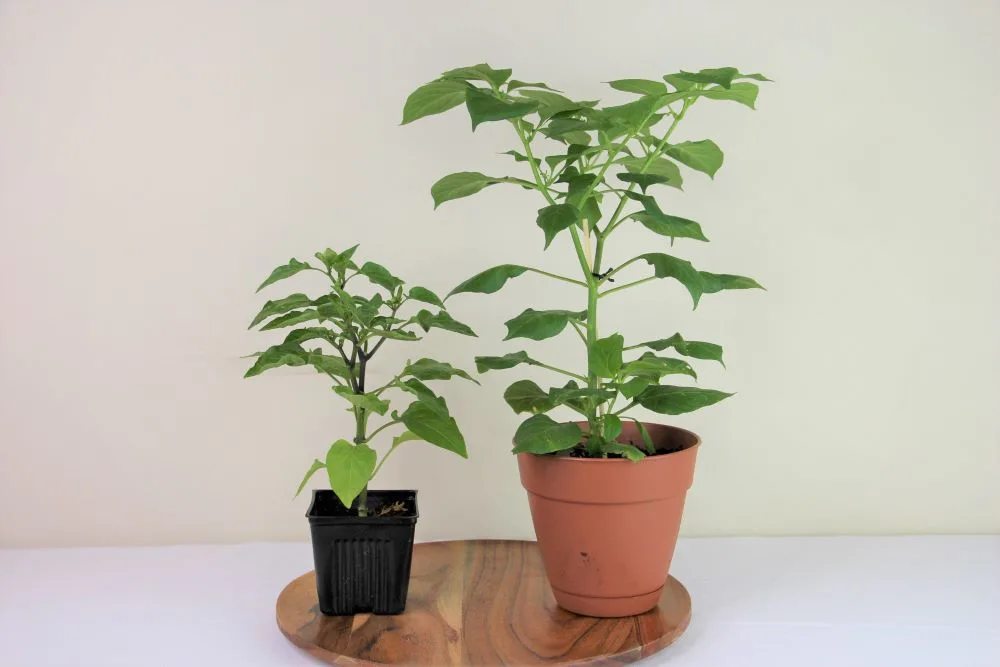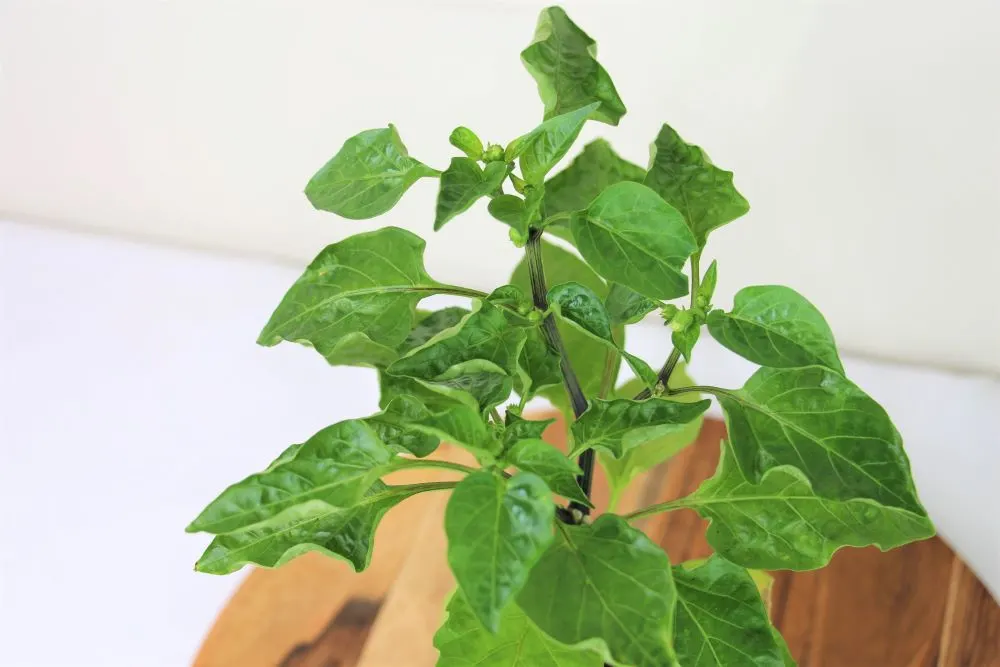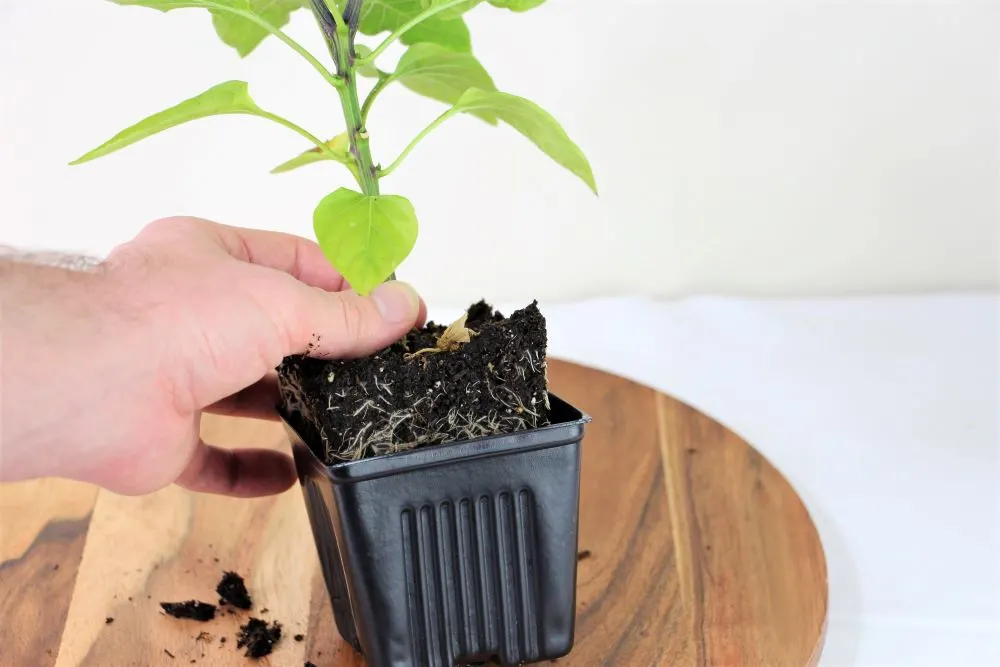Each year, we start our pepper plant seeds indoors in small pots. Many popular garden plants require early seed starting to give the plants a long enough grow period to produce fruits. These include tomatoes, peppers, melons and many more. If they are not properly transplanted into larger pots, your plants may become root bound.
Root bound plants will show you signs that they are in this state. Some plants are okay with being root bound, while most garden plants do not like it. In this article, we’ll cover how to identify and fix a root bound plant.

In This Article:
- What is root bound?
- Symptoms of a root bound plant
- How to check the roots
- How to fix a root bound plant (transplanting)
- Root pruning potted plants
Root Bound Plants (Video):
What Does ‘Root Bound’ Mean?
Let’s start by defining a root bound plant. When a plant is root bound, it’s root system has out-grown the pot in which it is planted, causing the root system to become entangled.
When a plant becomes root bound, it loses the ability to expand its root system and will often become stunted in size. If you buy garden plants from a nursery in late spring, there is a good possibility that they will be root bound.
Annual plants like tomatoes and peppers require a large container to grow to a mature and healthy size. To avoid these plants becoming root bound, be sure to transplant them at the right time. Perennial plants may become root bound each year, but most healthy plants can handle a root pruning every couple of years to encourage new growth.
Symptoms Of A Root Bound Plant
Root bound plants will show several signs of the condition. Having a root bound plant is almost always manageable and can be resolved easily. The first step however is identifying it to begin with. Here are a few common symptoms that a plant has become root bound.
Stunted Growth
The most obvious sign that your plant has become root bound is a slowing or stopping of growth. The size of your planter pot will determine how large any given plant will grow. This is due to the fact that the root system will eventually reach the walls of your pot, inhibiting the roots from expanding further.

Once your plant’s root system (or root ball) has reached the limits of the pot, the foliage of the plant will slow its growth rate. This is because there are fewer roots to absorb the oxygen and plant nutrients from the soil.
Many plants, including peppers, will take this as a sign to begin producing seeds, and so flowers will begin to form. The plant ‘thinks’ that it has reached its maximum size, and so it will move on to the next stage of growth, which is reproduction.
Make sure your plant ends up in an adequately large pot. Each type of plant requires a different amount of soil to grow. Some plants, like succulents and cacti, can happily grow in just a few ounces of soil.
On the other hand, peppers and tomatoes are happiest with at least 5 gallons of soil per potted plant. Be sure to do some research and transplant your plants into a large enough pot.
We love our 10″ and 12″ Saturn planter pots. Get some on Amazon here.
Visible Roots Above Soil Surface
Another sign of a more severely root bound plant are visible roots above the surface of the soil. This indicates that the plant’s roots have reached the sides and bottom of your pot and have continued to grow back up to the surface. At this stage, your plant is in serious need of attention, whether it is a transplant or a root pruning.
Curled or Disfigured Leaves
Another possible symptom of a root bound plant is a curling of new leafy growth. Curling leaves can be caused by a number of other factors, so this is not necessarily caused by a root bound plant. However, if your plants have been in the same sized pot for a while, the leaves may begin to curl.

If your plant is root bound, the newer leafy growth may appear to be curled or abnormal in shape. This is likely caused by a stressed root system trying to deliver nutrients to the new growth.
Next, if you have a suspicion that your plant is root bound, you can perform a simple check to confirm. If your plant is root bound, then it is time to consider taking some action to keep it healthy.
How To Check Your Root System
If you are fairly sure that your plants are root bound, you can simply check beneath the surface. When you are transplanting peppers or tomatoes, you can simultaneously do a quick check on the root ball to see if it is root bound. Or if you are just curious, you can check on your plants without transplanting.
Note: If you are working with a large pot, be sure you are outdoors to avoid messy soil spills.
Directions:
- Gently hold the base of the plant stem, just above the soil
- Squeeze the pot a few times to loosen the root ball from the pot
- Turn the plant sideways or upside down and wiggle it free from the pot
- If the plant is not root bound, be careful! You don’t want your delicate root system to be ripped up from the soil while it is still growing feeder roots
- Check the bottom of the plant for overlapping and intertwined roots

If the plant is root bound, you will see intertwined roots all around the root ball. The roots will likely be more dense toward the bottom of the pot, forming a tight cluster.
If you determine that you have a root bound plant, it is time to transplant to a larger pot or into the ground!
Transplanting A Root Bound Plant
Transplanting is simply the process of moving a potted plant into a large pot. We do this to save space when starting seeds and to avoid fungal issues early in the growing season. A root bound plant is a plant that waited too long to transplant. This doesn’t mean that your plant can’t still be remedied!
Here are a few steps to take when transplanting a root bound plant.
- Gently loosen the roots with your hands (wear gloves)
- Use a rolling motion, then pull away more stubborn root ‘clusters’
- It is okay if some roots ‘snap’ in the process
- Pour soil around the root ball in the new pot – this allows the soil to naturally fill in between the broken up root system
- Water thoroughly after transplanting
For a more thorough guide to transplanting, read our article about it here.
Root Pruning Potted Plants
If transplanting up to a larger pot is not an option, you may want to consider root pruning your plant. Root pruning, in tandem with normal stem pruning, may help potted perennial plants produce healthier growth.
Ideally you should root prune your plants in the late winter or early spring when it is still a bit chilly. The basic process may seem harsh, but if your plants are healthy, they can most likely handle it.
The basic process can be seen in action in this adorable video on YouTube.
Here are the general steps for root pruning your potted plants. Be sure to do a bit more research for the specific variety of plant that you are root pruning!
- Gently loosen and remove your plant ball from its pot
- Using a sharp knife, slice away about 0.5-1 inches of the roots from the edge of the plant on all 4 sides (this will give the plant a square shape looking down from above)
- Loosely comb out excess old soil from the root ball using your hands
- This helps expose the remaining roots and removes old soil
- Re-plant the root ball in fresh soil, adding more soil around the plant
- Water thoroughly
Root pruning is optional, but can help a plant grow healthy new growth when springtime rolls around. Only perform this if you are sure that your plant is over-crowded and you are not willing to move it to a larger pot!
I hope this article helped you identify and manage any root bound plants that you may have. Remember that it doesn’t have to mean the end of a plant. Good luck and feel free to share any questions or advice in the comments.



Bob
Saturday 13th of August 2022
Hello,
I have a carolina reaper plant in a 5 gallon pot. The plant right now is about 4.5' high and has about 20-30 reaper peppers on it and is constantly producing flowers. It looks amazing and is doing realllly well. However, I've noticed that over the last week I see very small roots coming out of the top of the pot. Should I be worried about it being rootbound? Like I said, the plant is producing like crazy and is very healthy. I only have about another two months left in my growing season max, so should I just let it alone?
thanks...
Pauline Crouse
Saturday 3rd of July 2021
I planted broccoli and cauliflower at the same time. The broccoli is now forming beautiful heads but the cauliflower is just green leaves. I don't see any head forming. If it is root bound can I did around it and place some cuts into the roots to promote growth. The leaves look healthy.
peppergeek
Wednesday 14th of July 2021
Hm, I'd be surprised if it isn't more to do with the plant variety than the growing conditions, but I'm not too sure..
Jordan Blackmer
Saturday 1st of May 2021
Hey, I think I’m at the point where my pepper plants need to be moved to bigger pots or planted outside. But the temperatures aren’t ideal outside yet and I don’t have enough room under the grow lights for all 54 of them to be re potted. Any advice?
peppergeek
Sunday 2nd of May 2021
Unfortunately the best thing is to wait it out and start hardening off on overcast days. If you want to, you can maybe up-size a few plants now and leave the others in smaller pots until temperatures rise. Also, maybe adjust your planting date for next year so that this time will coincide with the warmer weather next year!
Gray
Saturday 15th of August 2020
Hi, I have several pepper plants and I know they are all root bound, but they are also fruiting and I don’t want to jeopardize the peppers as I have about 45 peppers on my ghost and a decent amount on the others. Is it safe to transplant at this point? Any help would be much appreciated. Thanks in adavance!
peppergeek
Monday 17th of August 2020
Hi Gray,
I would not uproot and repot a plant that is fruiting. Wait for the plant to be in a more dormant state before you upsize the pot.
Cheers! -Calvin
Sara
Monday 3rd of August 2020
Hi! I am brand new to gardening this year and I just jumped in feet first, without a lot of forethought. I've had some success, but have learned A LOT from my many mistakes. Along with several tomatoes plants, I have two tiny jalapeno plants, one of which STILL doesn't have any fruit growing, only flowers that started a little over a week ago. (My soil is VERY alkaline [around 8 - 9] and I haven't had any success bringing the pH down.) I live in the inland NW and after the temperature allowed for transplanting, they went through quite a shock that took much too long to recover from. I am trying to focus on how I'll start next spring, and along with new raised beds and soil, I'm looking at using peat pots to start my seeds indoors. I think the idea is that they can be inserted straight into the ground, causing less transplant shock, but I don't know if they will cause root binding before the pots start breaking down. What are your thoughts? Thank you so much for sharing your knowledge and experience!
peppergeek
Tuesday 4th of August 2020
Hi Sara,
Glad to hear that you have started gardening! 2020 is a great year to start enjoying this hobby...
As for the peat moss pots, they typically break down quickly enough when in the ground. However, you can easily remove the bottom of the pots at the time of transplanting without disturbing the root system too much. This allows the lower roots to begin growing into the soil immediately.
Good luck and give us an update next year! -Calvin